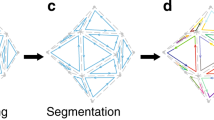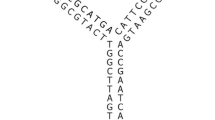Abstract
We propose a mathematical model of DNA self-assembly using 2D tiles to form 3D nanostructures. This is the first work to combine studies in self-assembly and nanotechnology in 3D, just as Rothemund and Winfree did in the 2D case. Our model is a more precise superset of their Tile Assembly Model that facilitates building scalable 3D molecules. Under our model, we present algorithms to build a hollow cube, which is intuitively one of the simplest 3D structures to construct. We also introduce five basic measures of complexity to analyze these algorithms. Our model and algorithmic techniques are applicable to more complex 2D and 3D nanostructures.
Supported in part by NSF Grants CCR-9531028 and EIA-0112934. Part of this work was performed while this author was visiting the Department of Computer Science, Yale University, New Haven, CT 06520-8285, USA, kao-ming-yang@cs.yale.edu.
Supported by a 2001 National Defense Science and Engineering Graduate Fellowship.
Access this chapter
Tax calculation will be finalised at checkout
Purchases are for personal use only
Preview
Unable to display preview. Download preview PDF.
Similar content being viewed by others
References
J. Chen and N. C. Seeman. The synthesis from DNA of a molecule with the connectivity of a cube. Nature, 350:631–633, 1991.
A. Condon, R. M. Corn, and A. Marathe. On combinatorial DNA word design. In Winfree and Gifford [12].
T.-J. Fu and N. C. Seeman. DNA double-crossover molecules. Biochemistry, 32:3211–3220, 1993.
T. H. LaBean, E. Winfree, and J. H. Reif. Experimental progress in computation by self-assembly of DNA tilings. In Winfree and Gifford [12].
T. H. LaBean, H. Yan, J. Kopatsch, F. Liu, E. Winfree, H. Reif, and N. Seeman. The construction, analysis, ligation and self-assembly of DNA triple crossover complexes. J. Am. Chem. Soc., 122:1848–1860, 2000.
I. V. Markov. Crystal Growth for Beginners: Fundamentals of Nucleation, Crystal Growth, and Epitaxy. World Scientific, Singapore, 1995.
P. Rothemund and E. Winfree. The program-size complexity of self-assembled squares. In F. F. Yao, editor, Proceedings of the 32nd Annual ACM Symposium on Theory of Computing, Portland, OR, 21–23 May 2000. ACM Special Interest Group on Algorithms and Computation Theory.
N. C. Seeman. Nucleic-acid junctions and lattices. Journal of Theoretical Biology, 2:237–247, 1982.
H. Wang. Proving theorems by pattern recognition. Bell System Technical Journal, 40:1–42, 1961.
E. Winfree. On the computational power of DNA annealing and ligation. In E. B. Baum and R. J. Lipton, editors, DNA Based Computers, DIMACS: Series in Discrete Mathematics and Theoretical Computer Science, pages 199–210. American Mathematical Society, May 1995.
E. Winfree, T. Eng, and G. Rozenberg. String tile models for DNA computing by self-assembly. In A. Condon and G. Rozenberg, editors, DNA Based Computers VI, Leiden, The Netherlands, 13–17 June 2000. Leiden Center for Natural Computing.
E. Winfree and D. Gifford, editors. Preliminary Proceedings, Fifth International Meeting on DNA Based Computers, Cambridge, Massachusetts, 14–15 June 1999. DIMACS.
E. Winfree, F. Liu, L. A. Wenzler, and N. C. Seeman. Design and self-assembly of two-dimensional DNA crystals. Nature, 394:539–544, 1998.
Author information
Authors and Affiliations
Editor information
Editors and Affiliations
Rights and permissions
Copyright information
© 2001 Springer-Verlag Berlin Heidelberg
About this paper
Cite this paper
Ming-Yang, K., Ramachandran, V. (2001). DNA Self-Assembly For Constructing 3D Boxes. In: Eades, P., Takaoka, T. (eds) Algorithms and Computation. ISAAC 2001. Lecture Notes in Computer Science, vol 2223. Springer, Berlin, Heidelberg. https://doi.org/10.1007/3-540-45678-3_37
Download citation
DOI: https://doi.org/10.1007/3-540-45678-3_37
Published:
Publisher Name: Springer, Berlin, Heidelberg
Print ISBN: 978-3-540-42985-2
Online ISBN: 978-3-540-45678-0
eBook Packages: Springer Book Archive




